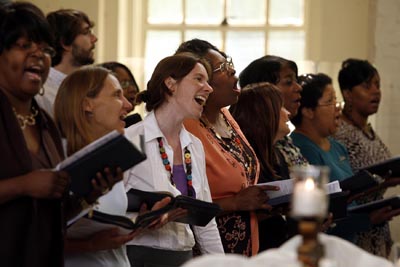
(RNS1-JUNE10) The choir performs at First Grace United Methodist Church in New Orleans. The church was the result of a merger between two churches — one black, one white — in the wake of Hurricane Katrina. For use with RNS-NOLA-METHODISTS, transmitted June 10, 2009. Religion News Service photo by Jennifer Zdon/The Times-Picayune.
NEW ORLEANS — Nearly four years after Hurricane Katrina smashed their New Orleans area churches and scattered their communities, Louisiana Methodists have crossed an invisible boundary into the future, leaving behind the rescue subsidies and ad hoc rebuilding arrangements that have nourished more than 40 wounded churches since 2005.
“Basically, we’re entering the `new normal,”‘ said Bishop William Hutchinson.
The last few storm-damaged congregations are now largely self-supporting, no longer aided by an estimated $7 million in outside subsidies that United Methodists nationwide poured into dozens of local churches after Katrina.
Moreover, the denomination is about to dismantle the last remnant of a post-Katrina emergency reorganization that propped up damaged congregations and bought them time to consider their futures.
Even the last three hard-hit congregations seem fit enough to strike out on their own. Refurbished by trauma, the Methodist community around metro New Orleans is smaller now, but arguably more vibrant, Hutchinson said.
It is the product of almost four years of patient restructuring driven by a bottom-up process that allowed dozens of damaged local congregations to come to their own decisions about their future — with guidance, but few commands, from the church leaders in Baton Rouge.
And although occasionally painful, the process worked without major blow-ups — no seized churches or public spillover of anger that marked the more centralized and top-down Catholic experience.
“We’ve been involved in a four-year conversation with all of our churches about what they can and can’t do; what’s realistic, what’s not,” said the Rev. Ramonalynn Bethley, the district superintendent and Hutchinson’s liaison to 68 Methodist churches in southeast Louisiana.
“It wasn’t a complete do-over, but it was pretty near a do-over,” said the Rev. Ellen Blue, a faculty member at Phillips Theological Seminary in Tulsa, Okla., who has been living in New Orleans for a year researching a book on the reorganization.
Before the storm, local United Methodists numbered about 26,000; now the figure is about 23,000, according to church figures. Forty-two affected congregations have now shrunk to 30. Six closed; another 11 consolidated into five new communities.
Methodist leaders said Katrina finished off weak communities, swept away bad habits of complacency in others and, in one or two cases, gave rise to new racially or economically mixed congregations that could not have been born outside of crisis.
They hope the forced pruning yields lasting benefits.
“The churches today are stronger than the churches that existed before,” said Hutchinson. “They have more possibilities for growth, more possibilities for doing outreach into the city, more possibilities for reaching out beyond their walls.”
One frequently cited example is First Grace United Methodist Church, the growing, post-storm merger of two congregations, one white, one black — with a new Hispanic presence.
“I think First Grace is what heaven looks like. That’s a gift from Katrina we wouldn’t have had otherwise,” Bethley said.
Like other faith communities, Methodists began reorganizing as soon as the water drained from New Orleans in 2005.
Within weeks, church leaders in Baton Rouge found jobs around the state for 90 displaced New Orleans clergy. That done, Hutchinson and his staff fashioned a plan to create seven “mission zones” around the metro area. Damaged congregations in each zone were clustered around one surviving church.
From the beginning, Hutchinson and others said, the mission-zone clusters were deliberately assembled so as to be diverse and multicultural. The idea was to prop up damaged congregations and buy time to figure out the future. The plan was so ad hoc it soon acquired an informal name: the “for now” plan.
Backed by national financial aid, Methodist planners were able to make time an ally. Months rolled by; missing church members either returned or announced they weren’t coming back. Clarity began to emerge.
By last summer, most of the 40 or so affected congregations had decided they could make it on their own — or had come to realize they needed to close or merge with another congregation.
“We were basically letting them do it,” Hutchinson said.
At this point last year, after two years of the “for now” plan, Methodists elected to give the last few marginal congregations one more year to come to a decision.
They called it, inelegantly but aptly, the “manure plan,” after a parable in the Gospel of Luke in which a gardener asks his master to spare a sickly fig tree for another year, while he spreads fertilizer in a concerted attempt to save it.
“We knew we had one more year of those (national) funds. So we decided to pour resources into those churches” in a make-or-break year of recovery, Hutchinson said.
The church has now reached the end of the “manure plan” and the beginning of life, unassisted, for the last few survivors, Hutchinson said. Church leaders say they’re generally pleased with the outcome, though it remains a work in progress.
“We’re Methodists,” said Bethley. “We like discipline; we live according to our Book of Order. But Katrina brought chaos. And we had to do the best we could.”
(Bruce Nolan writes for The Times-Picayune in New Orleans.)




